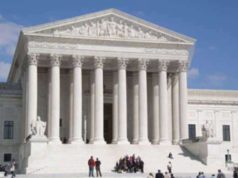Table of Contents

The Supreme Court of the United States is the highest court in the nation, and it plays a vital role in interpreting the Constitution and federal law. The Court consists of nine justices who are appointed by the President and confirmed by the Senate. One unique aspect of the Supreme Court’s structure is that once appointed, justices serve for life. This system of lifetime appointments has generated debate over the years, with some arguing that it provides stability and independence to the Court, while others contend that it prevents accountability and perpetuates political biases. In this article, we will explore the purpose of lifetime appointments for Supreme Court justices and examine the pros and cons of this system.
Purpose of Lifetime Appointments
One of the primary reasons that Supreme Court justices are granted lifetime appointments is to ensure their independence from partisan politics and influence. The Founding Fathers recognized that the judiciary’s impartiality was essential to the proper functioning of the government and the prevention of corruption. Therefore, they designed the Supreme Court to be a check on the power of the other branches of government, with justices appointed for life to guarantee their judicial independence.
Lifetime appointments also provide stability to the Court, which is essential since the Supreme Court interprets the Constitution and establishes long-lasting precedents that shape American law. Justices are appointed for a lifetime so that they can take a long-term view of legal issues and address potential issues in the future. This also helps ensure that the Court is not subject to frequent changes or political considerations.
Additionally, lifetime appointments allow justices to gain significant expertise and experience, which is beneficial for the functioning of the Court. Justices are able to bring a wealth of knowledge and experience to the bench, and this accumulated over time enhances their legal knowledge base and expertise.
Pros of Lifetime Appointments
Judicial Independence
One critical advantage of lifetime appointments is that they help safeguard the independence of the judiciary. By appointing justices for life, the Founding Fathers intended to create a check on the other branches’ potential abuse of power. Supreme Court justices are not subject to political pressure or influence, as they do not have to seek reelection or curry favor with political parties. This helps ensure that they are free to interpret the Constitution and federal law without any undue influence.
Stability
Another significant advantage of lifetime appointments is the stability it provides to the Supreme Court. The U.S. Constitution is a living document, and its interpretation requires a long-term view. The Supreme Court’s decisions are meant to guide American law and society for generations to come, and lifetime appointments ensure that justices can take a long-term perspective. Additionally, lifetime appointments prevent the Court from being subject to the whims of political parties and help ensure that the Court remains independent.
Expertise and Experience
Lifetime appointments also enable justices to gain significant knowledge, expertise, and experience. They can adjudicate cases over an extended period of time, which allows them to develop a deep understanding of how the law operates in practice. This expertise and experience allows them to draw on their legal knowledge and make informed decisions when interpreting the Constitution and federal law.
Cons of Lifetime Appointments
Lack of Accountability
One significant drawback of lifetime appointments is that they lack accountability. While the Constitution provides mechanisms for removing justices through impeachment, this has only been attempted once, in 1804, and ultimately was unsuccessful. This means that Supreme Court justices are not subject to direct accountability by the American people, and can only be removed in exceptional circumstances.
Political Bias
Another significant potential drawback of lifetime appointments is political bias. Supreme Court justices are appointed by the President and confirmed by the Senate, and political considerations can play a role in these appointments. This can result in justices who have strong political leanings, and this can color their legal interpretations. Additionally, a justice’s political ideology can change over time, meaning that they may continue to shape the Court’s decisions long after they no longer represent the views of the American people.
Inflexibility
Lifetime appointments can also limit the Supreme Court’s flexibility. Justices serve for a long period of time and may not be in line with the current state of the law or society. Societal attitudes towards laws or legal interpretations can change significantly over time, and Justices who are not in tune with these changes can impede necessary updates.
Conclusion
The lifetime appointment of Supreme Court Justices is an essential aspect of American law, meant to protect the Court’s independence and stability long-term. Despite these benefits, the system has its drawbacks, mainly related to accountability, political bias, and inflexibility. Both the benefits and drawbacks of lifetime appointments highlight the need for careful consideration when appointing justices and keeping checks and balances on the judiciary. While there are valid arguments for both sides of the debate, a balance between stability, independence, and accountability ultimately serves as the best system for America’s judicial system.
The Constitution provides for the lifetime appointment of every Supreme Court Justice, though not through any direct language.
Supreme Court Justice Ruth Ginsburg passed away at the age of 87 on September 18th of 2020.
A new justice will be appointed by the President to take the position in the Supreme Court for a Lifetime Appointment.
Instead, the document addresses the ability of Court Justices to hold office “during good Behavior” and does not provide for the necessity that a Court Justice resign after a certain age or period of service.
This lack of a term limit was first implemented during the tenure of John Marshall, the fourth Chief Justice, to indicate that Court Justices could remain on the bench for the remainder of their lives, as did Marshall.
Though the requirement for “good behavior” presents the one exception to the lifetime term of a Court Justice, as can be implemented in law through Congressional impeachment, this option is rarely used and not often seriously considered.
The single instance of this happening, the impeachment of Samuel Chase in 1805, ended with the Congressional determination that the move was purely political and lacked acceptable grounds for proceeding.
The basic purpose of lifetime appointment is to assure the integrity of the power granted to Court Justices and protect them against unwarranted interference from either the legislative or executive branch.
The express and implicit separation of the Supreme Court from the other branches of Government is therefore upheld. In accordance with the principle of providing checks and balances, the executive and legislative branches exercise control over the Supreme Court by, respectively, proposing and approving candidates for that body.
In the highly politicized atmosphere which has long attended the nominally apolitical arena of Court Justices, Presidents often attempt to buttress their agendas by selecting Court Justice nominees favorable toward their views.
At times, however, the judicial leanings of Court Justices prove
different in practice than they had previously appeared. The policy of lifetime appointment, therefore, secures a Court Justice against “retribution” for decisions going against the wishes of his or her Presidential sponsor.
In this regard, proponents have cited Alexander Hamilton’s declaration in the Federalist Papers that “nothing can contribute so much to its firmness and independence as permanency in office”.
Various concerns have also been raised about the ways in which lifetime appointment impinges on the office of Supreme Court Justices.
One concern is that this policy encourages the Supreme Court to be dominated by thinking better fitted to the formative years of the Court Justices than to the present-day conditions of the United States.
In this view, the Supreme Court would be better served by more frequent turnover in its membership.
Another issue that has been raised in the mental capacities of a Supreme Court Justice becoming diminished with age. This possibility could not conceivably fall under the purview of the requirement for “good Behavior” and at present is not provided for under U.S. law.
Criticisms of the general policy of lifetime, the appointment has also been stoked by the criticism of specific Supreme court Justices and of the Court’s culture in general for moving toward a more legislative, politicized function, which critics might find it less problematic if offenders did not remain on the bench for so long.



















